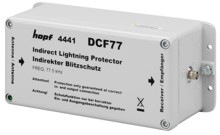DCF77 Indirect Lightning Protection 4441 / 4444
Short Description
When using outdoor antennas the antenna cables may experience high interference voltages caused by thunderstorms. This may destroy or damage not only the directly connected radio controlled clock systems but also other connected devices.
An indirect lightning protection should be connected between outdoor antenna and radio controlled clock board to avoid high cost and subsequent damages.
Indirect lightning protection 4441
To achieve this it is necessary to short-circuit all the lines with over voltages to reduce it as quickly as possible. Once the interference is over the device is to return to its previous specifications. The hopf indirect lightning protection consists of a combination of different components.
Fast absorber diodes keep the potential difference between antenna core and 0 constantly. The following gas arresters, once lit, short-circuit the line to the earthing point. It is due to this combination that the potential separation of the antenna circuit from the other electronics is guaranteed even in undisturbed situations. If the indirect lightning protection itself is destroyed by a flash of lightning the lines stay shortcircuited. Therefore no DCF77 signal is received. We advise using the status bits in the connected devices to check.
When using the hopf indirect lightning protection we presume that a comprehensive lightning protection concept is in operation on location, including a direct protection of the building according to VDE and also that the voltage supply of the device is protected from lightning. The indirect lightning protection is usually installed directly where the cable enters the building. Therefore in-house cables running parallel to the antenna cable are disturbed as little as possible.
The antenna is connected to the BNC input-connector of the indirect lightning protection - the extended line to the electronics is connected to the BNC-output connector. A copper stranded wire is run from the earthing screw to the nearest earth connection point.
It is important that the earth line of the connected device has the same earth connecting point as the indirect lightning protection, to avoid destructive potential differences. If this cannot be guaranteed, the indirect lightning protection should be installed at a different place.
If the indirect lightning protection is installed near the device the earth cable can be connected to the earth of the device. In this case the antenna cable between antenna and indirect lightning protection should not run parallel to other cables.
4x antenna amplifier with indirect lightning protection 4444
If several DCF77-antennas are required in a building, the indirect lightning protection can be supplied with a 4x potential free antenna amplifier.
The lightning protection housing contains, apart from the indirect lightning protection, a power supply and several amplifier modules. The antenna input is on one of the narrow sides of the housing, whereas the cableinlet for the voltage supply cable is on the other narrow side.
The DCF77 signal is fed to a pre-amplifier via the antenna input. The amplified signal is then fed to 4 potential free output steps, which carry the signal on to the insulated BNC antenna connectors on the broader sides of the housing.
To connect the supply voltage the lid of the housing has to be removed by undoing the screws and connecting the cable through the leading-in hole to the appropriate terminals.
We supply two versions of the 4x antenna amplifier:
- FG444400 4x antenna amplifier with indirect lightning protection
- FG444600 4x antenna amplifier
Technical Data
| Indirect lightning protection 4441 | |
|---|---|
| type of housing: | aluminium-die-cast-housing |
| dimensions (W x H x D): | 250 x 105 x 95 mm |
| weight: | approx. 3.5 kg |
| earth connection point | |
| thickness of the copper stranded wire: | min. 10 mm² |
| length of the copper stranded wire: | max. 10 m |
| Current stability: | 10 kA (8/20 μsec-wave) |
| speed of response: | < 1 nsec. |
| protection level at 6kA 1.2/50 μs, wave at input: | < 12 V |
| insertion loss for DCF77 signal: | max. 3 dB |
| input / output: | BNC-connector (female/female) |
| input / output impedance: | 50 Ω |
| temperature range | |
| operation: | -20° C to +80° C |
| storage: | -40° C to +85° C |
| humidity: | 95% non-condensing |
| protection class: | IP40 |
| 4x multi aerial amplifier with indirect lightning protection 4444 | |
| Type of housing: | aluminium-die-cast-housing |
| dimensions (W x H x D): | 250 x 105 x 95 mm |
| weight: | approx. 3.5 kg |
| earth connection point | |
| thickness of the copper stranded wire: | min. 10 mm² |
| length of the copper stranded wire: | max. 10 m |
| power supply: | 230V AC ± 10% |
| power consumption: | 6 VA max. |
| fuse: | thermal cutout |
| Current stability: | 10 kA (8/20 μsec-wave) |
| speed of response: | < 1 nsec. |
| Protection level at 6kA 1,2/50 μs, wave at input: | < 12V |
| insertion loss for DCF77 signal: | max. 3 dB |
| input / output: | BNC-connector (female/female) |
| input / output impedance: | 50 Ω |
| length of cable antenna - amplifier: | max. 500 m |
| length of cable amplifier - clock: | max. 500 m |
| amplification: | 0 to 3 dB |
| temperature range | |
| operation: | -20° C to +80° C |
| storage: | -40° C to +85° C |
| humidity: | 95% non-condensing |
| protection class: | IP40 |
Pictures
Downloads
PDF documents
Software and Driver
- For this product there is no Software / Driver available.








